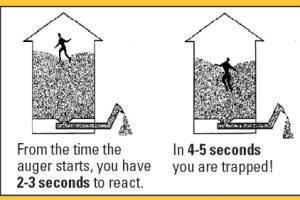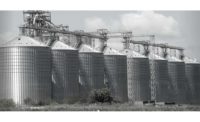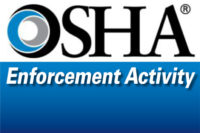 It takes only five seconds for a worker who is walking on moving grain to become engulfed in it to the extent that he is unable to extricate himself. It only takes 60 seconds for him to become completely submerged.
It takes only five seconds for a worker who is walking on moving grain to become engulfed in it to the extent that he is unable to extricate himself. It only takes 60 seconds for him to become completely submerged.
Moving grain acts like "quicksand" that can bury a worker before he has time to react. "Bridged" grain and vertical piles of stored grain can also collapse unexpectedly if a worker stands on or near it. The behavior and weight of the grain make it extremely difficult for a worker to get out of it without assistance.
It happens all too often. In the past 50 years, more than 900 cases of grain engulfment have been reported with a fatality rate of 62 percent, according to researchers at Purdue University in Indiana. And those numbers are going up, not down. At least 26 of those deaths occurred in 2010 – the highest number on record.
It’s no wonder that OSHA is revving up efforts to prevent this very preventable type of occupational fatality. In addition to its Local Emphasis Program for Grain Handling Facilities (which includes falls, auger entanglement, "struck by," combustible dust explosions and electrocution hazards in addition to engulfment), the agency has formed partnerships with grain handling companies and associations in five Midwestern states: Wisconsin, Ohio, Kansas, Nebraska and Missouri.
These alliances can engage in a variety of activities:
- OSHA and its partners meet regularly to discuss projects and educate employers about hazards:
- Information is disseminated through the newsletters and websites of grain handling associations and agricultural extension services
- Signage – such as a decal program developed by OSHA, the Grain and Feed Association of Illinois and the Illinois Grain Handling Safety Coalition – can be distributed to facilities. These “stop sign” decals adhere to grain bin doors and use pictures and short phrases to remind entrants to stay clear of waist high grain, cover floor holes and follow other best practices.
Nick Walters, OSHA Regional Administrator for six midwestern states, said alliances let the agency work together with local industries to train employers and workers about the unique hazards they face.
“We are committed to preventing the injuries and deaths that have been too frequent in the industry in recent years," said Walters.
OSHA also has a wealth of information about common grain industry hazards and abatement methods, proper bin entry techniques, sweep auger use, and many other grain related topics at www.osha.gov/SLTC/grainhandling/index.html. OSHA's Grain Bin LEP is used in 25 states.
Individuals and companies who’d like the stop sign decal can email the Grain and Feed Association of Illinois at info@gfai.org to request it.



